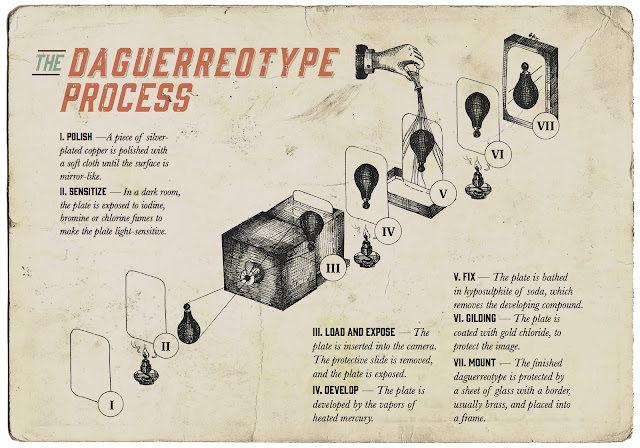What is a "Mirrorless" Camera?
I've found myself thinking this seemingly simple question with an obvious answer: what are mirrorless cameras? And further what is the point of them?
Now you might answer that everyone knows what a "mirrorless" camera is. They are very popular after all. The trouble is that a pinhole camera made from a shoebox has no mirror and is, therefore, a mirrorless camera. The earliest daguerreotype cameras introduced in 1839 were also a mirrorless design.
 |
| ILLUSTRATION: SUSANNA CELESTE CASTELLI, DENSITYDESIGN RESEARCH LAB; SOURCE: GEORGE EASTMAN HOUSE INTERNATIONAL MUSEUM OF PHOTOGRAPHY AND FILM |
Contrary to popular opinion, rangefinder cameras are also mirrorless cameras. Why? Simple: they have no mirror!
So what makes 21st-century "mirrorless cameras" different then to daguerreotype cameras and rangefinders from the nineteenth to early twentieth century? The answer is the electronic viewfinder. We should really call them "mirrorless electronic viewfinder cameras" (ML-EVF cameras). The term "mirrorless interchangeable lens camera" (MILC) is thus silly as it fails to distinguish between an ML-EVF camera, a rangefinder, and a daguerreotype camera. Some use the term electronic viewfinder interchangeable lens camera (EVIL) but that fails to distinguish between EVF cameras with and without a mirror. Yes, there are EVF cameras with mirrors, albeit semi-translucent pellicle mirrors, making them pellicle mirror EVF cameras (PM-EVF cameras):
 |
| The Sony a99II is an EVF camera, yet it has a semi-translucent pellicle mirror and is therefore not a "mirrorless" camera. Not all EVF cameras are mirrorless. |
Nor are all ML-EVF cameras interchangeable lens cameras. Good examples with fixed lenses include the Fuji X100 series:
 |
| Not all EVF cameras are interchangeable lens designs. The Fuji X100F has a fixed 23mm f/2 lens Other makers also offer similar fixed lens ML-EVF cameras |
The point is that the real technological breakthrough inherent to the "mirrorless" comes from the addition of the electronic viewfinder (EVF), not the alleged "removal" of a reflex mirror. In fact, far from being a DSLR with the mirror removed, a mirrorless camera is more like a rangefinder from which the optical viewfinder and rangefinder focusing system has been replaced with an EVF. So perhaps an alternative name might be an EVF rangefinder, but then again without an optical rangefinder, it wouldn't be a rangefinder. In any case, the importance of the EVF has been much underestimated. Advances in mirrorless cameras and their increasing popularity should be put down as much to the improvements in EVF quality (image quality and reduction of image lag) as to any other factor.
The point of this discussion is that if you can take a rangefinder and replace the optical viewfinder with an EVF, then you can do the same with other types of cameras. You can even do this with an SLR type of camera. A DSLR in which the reflex mirror is replaced with an EVF is called either an SLT (single lens translucent) or, alternatively, a pellicle mirror EVF camera (PM-EVF). The mechanical moving part in the form of a reflex mirror is replaced with a fixed semi-translucent pellicle mirror design.
The question as to why you might not yet want to replace the optical viewfinder on a DSLR with an EVF is simple: electronic viewfinders are still too primitive. Only once EVF resolution and speed have caught up, will the EVF mirror design camera become meaningful. At the moment, the difficulty in achieving both complete elimination of blackouts and reduction of residual viewfinder lag to imperceptible levels, make the EVF in SLT cameras problematic for what SLR cameras are best at: fast autofocus shooting rapidly moving subjects based on the dedicated off-imaging focal plane PDAF sensor. For that, the EVF quality must match or exceed what you get from an optical viewfinder. Once EVF technology improves sufficiently, my prediction is that both Canon and Nikon will transition their SLR systems to EVF technology based SLT systems. To do otherwise would entail these companies effectively abandoning their SLR systems in favour of mirrorless EVF systems. They have too much invested in SLR systems to do that.
Conclusions
With technological improvements in EVF quality, EVF cameras are becoming increasingly popular. The key technological change is the gradual replacement of the optical viewfinder with an EVF and not the removal of a mirror. There are two types of EVF cameras: mirrorless EVF cameras (ML-EVF) and pellicle mirror EVF cameras (PM-EVF).



Comments
Post a Comment